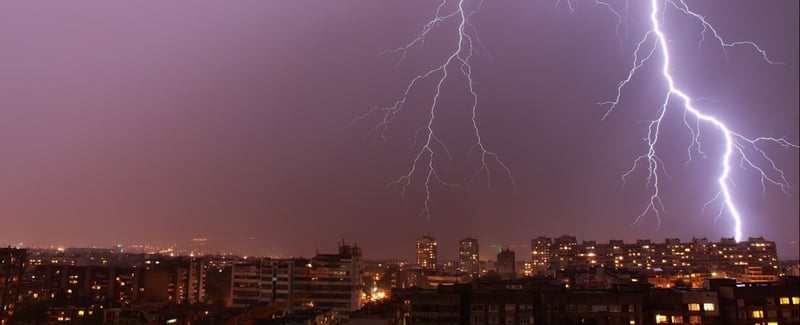Lightning Protection
As much as we wish that the weather didn't affect daily business operations, we understand that extreme cases can still present consequences. Depending on the location of your facility, disruptive weather may be extreme or miniscule, frequent or rare. While events like earthquakes might never effect your facility's operations, lower energy transient events such as lightning could be the source of significant damage to your sensitive, microprocessor-based systems within a radius of several miles.
Unnoticed damage from lightning over time includes:
-
Degradation of electrical or electronic systems
-
Compromised signal communications systems
-
Data loss
-
Equipment destruction
It is important to note that lightning does not need to directly strike a power line for such damage to occur; a strike several hundred meters away can induce large damaging transients, even to underground cables.

The Need for Coordinated Protection
If you're looking to minimize the threats caused by transient voltages, nVent recommends taking a holistic approach. A coordinated surge protection system is crucial for ensuring protection during a major electrical event and prolonging the life of equipment by reducing the impact of low-magnitude transient events.
Grounding, bonding and lightning protection systems can afford your facility reliable protection of structures, industrial and commercial operations; however, each of these systems are interdependent disciplines that require a systematic design approach to avoid vulnerable “blind spots”.
For example, if you install a surge protective device (SPD) on the power supply to a programmable logic controller, you'll leave your I/O lines unprotected.
In addition, an air terminal on your facility might very well capture lightning energy, but without a dependable ground system, this energy cannot be safely dissipated. Even the most premium SPDs perform better with a proper ground reference.
Key Takeaway: These interdependent disciplines are best applied when looking at a total facility rather than at an individual piece of equipment or portion of the facility.
More Sources of Surges
Although lightning is the most spectacular form of externally generated surges, it is only one source of surge events.
Other sources include, but are not limited to:
-
Switching of power circuits
-
Operation of electrical equipment by neighboring facilities
-
Switching of power factor capacitor banks
-
Switching and clearing of faults on power transmission and distribution lines
It is estimated that 80% of all transients are generated internally within one’s own facility by the switching of electrical loads such as office equipment, nonlinear loads, pumps, welders, compressors, heating systems and motors.
Solutions For You
nVent ERICO has been a leading expert in electrical protection solutions offering power protection, specialized power protection and data and signal protection. Contact your local Accu-Tech Representative to learn more about Lightning Protection Solutions from nVent ERICO.




.png?width=58&height=58&name=X_logo_2023_(white).png)
